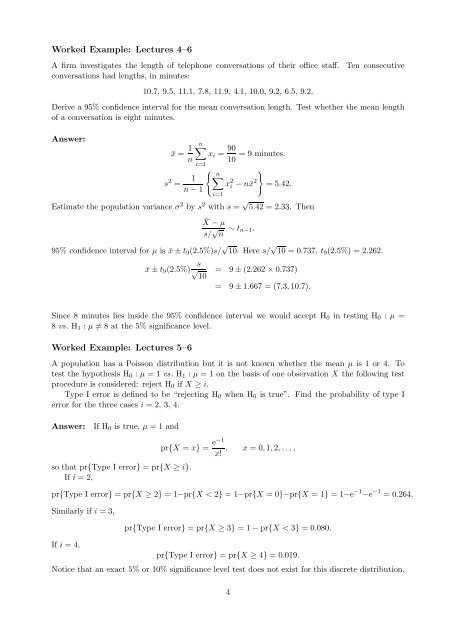MATH1725 Introduction to Statistics: Worked examples
MATH1725 Introduction to Statistics: Worked examples
MATH1725 Introduction to Statistics: Worked examples
You also want an ePaper? Increase the reach of your titles
YUMPU automatically turns print PDFs into web optimized ePapers that Google loves.
<strong>Worked</strong> Example: Lectures 4–6<br />
A firm investigates the length of telephone conversations of their office staff. Ten consecutive<br />
conversations had lengths, in minutes:<br />
10.7, 9.5, 11.1, 7.8, 11.9, 4.1, 10.0, 9.2, 6.5, 9.2.<br />
Derive a 95% confidence interval for the mean conversation length. Test whether the mean length<br />
of a conversation is eight minutes.<br />
Answer:<br />
¯x = 1 n∑<br />
x i = 90<br />
n 10 = 9 minutes.<br />
i=1<br />
{ n∑<br />
}<br />
s 2 = 1 x 2 i<br />
n − 1<br />
− n¯x2 = 5.42.<br />
i=1<br />
Estimate the population variance σ 2 by s 2 with s = √ 5.42 = 2.33. Then<br />
¯X − µ<br />
s/ √ n ∼ t n−1.<br />
95% confidence interval for µ is ¯x ± t 9 (2.5%)s/ √ 10. Here s/ √ 10 = 0.737, t 9 (2.5%) = 2.262.<br />
s<br />
¯x ± t 9 (2.5%) √ = 9 ± (2.262 × 0.737)<br />
10<br />
= 9 ± 1.667 = (7.3,10.7).<br />
Since 8 minutes lies inside the 95% confidence interval we would accept H 0 in testing H 0 : µ =<br />
8 vs. H 1 : µ ≠ 8 at the 5% significance level.<br />
<strong>Worked</strong> Example: Lectures 5–6<br />
A population has a Poisson distribution but it is not known whether the mean µ is 1 or 4. To<br />
test the hypothesis H 0 : µ = 1 vs. H 1 : µ = 1 on the basis of one observation X the following test<br />
procedure is considered: reject H 0 if X ≥ i.<br />
Type I error is defined <strong>to</strong> be “rejecting H 0 when H 0 is true”. Find the probability of type I<br />
error for the three cases i = 2, 3, 4.<br />
Answer: If H 0 is true, µ = 1 and<br />
so that pr{Type I error} = pr{X ≥ i}.<br />
If i = 2,<br />
pr{X = x} = e−1<br />
x! , x = 0,1,2,... ,<br />
pr{Type I error} = pr{X ≥ 2} = 1−pr{X < 2} = 1−pr{X = 0}−pr{X = 1} = 1−e −1 −e −1 = 0.264.<br />
Similarly if i = 3,<br />
If i = 4,<br />
pr{Type I error} = pr{X ≥ 3} = 1 − pr{X < 3} = 0.080.<br />
pr{Type I error} = pr{X ≥ 4} = 0.019.<br />
Notice that an exact 5% or 10% significance level test does not exist for this discrete distribution.<br />
4

















